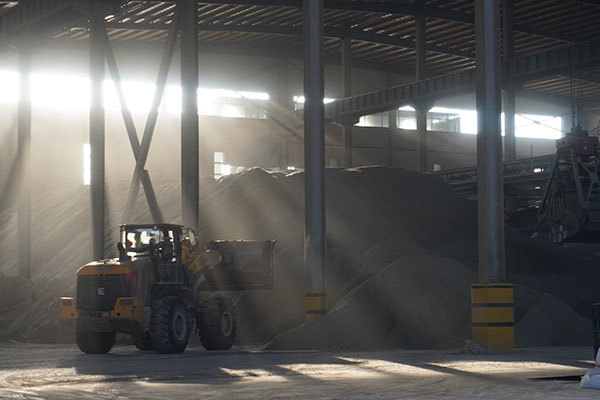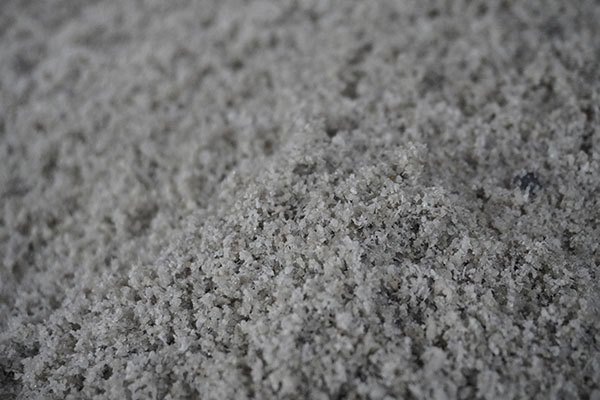Water slag, also known as "water-hardened slag", is a good active mix that can be made into clinker-free cement.
Release Time:
Jan 26,2024
The main use of slag slag, also known as water quenching slag, is a very good active mix. However, due to the high hardness of water slag and poor abrasiveness, at present, only a small number of cement manufacturers as a cement mixer, and most steel mills will be water slag as a waste pile, not only occupies a large amount of arable land, and pollution of the environment.
The main use of slag slag, also known as water quenching slag, is a very good active mix. However, due to the high hardness of water slag and poor abrasiveness, at present, only a small number of cement manufacturers as a cement mixer, and most steel mills will be water slag as a waste pile, not only occupies a large amount of arable land, and pollution of the environment. (1) Production of slag cement. Water slag has potential water-hardening and cementing properties, and can show water-hardening and cementing properties under the action of cement clinker, lime, gypsum and other exciters, which is a high-quality raw material for cement.
02 Water slag can be used either as cement mix or made into clinkerless cement. Slag silicate cement is made by mixing and grinding silicate cement clinker and water slag with 3%~5% gypsum, or mixing them evenly after grinding them separately. Slag silicate cement is referred to as slag cement. When grinding slag cement, the amount of blast furnace slag has little effect on the compressive strength of the cement, but less on the tensile strength, so the amount of slag can be added to account for 20% to 85% of the weight of the cement. In this way, it is very favourable to improve the quality of cement and reduce the cost of cement production.
03 Gypsum slag cement is a kind of water-hard cementitious material obtained by mixing and grinding dry water slag and gypsum, silicate cement clinker or lime according to a certain proportion or grinding them separately and then mixing them evenly. In the preparation of gypsum slag cement, blast furnace slag is the main raw material, and the general dosage can be as high as about 80%. This kind of gypsum slag cement has lower cost, better resistance to sulphate erosion and permeability, and is suitable for concrete hydraulic buildings and various precast blocks.
04 Lime slag cement, is a water-hard cementitious material made by grinding dry water slag, quicklime or slaked lime and natural gypsum of less than 5 per cent in suitable proportions. The amount of lime is generally 10% to 30%, its role is to stimulate the active ingredients in the water slag to generate hydrated calcium aluminates and hydrated calcium silicates. Lime admixture is too little, the active ingredients in the water slag is difficult to fully stimulate; admixture is too much, it will make the cement coagulation is not normal, strength decline. Lime slag cement can be used for steam curing of various concrete pre-products, unreinforced concrete in water, underground, pavement, etc. and industrial and civil construction mortar.
05 The main use of water slag water slag is also called water quenching slag, is a good active mix. However, due to the high hardness of water slag and poor abrasiveness, at present, only a small number of cement manufacturers as a cement mixer, and most of the steel mills will be water slag as a waste pile, not only occupy a large amount of arable land, and pollution of the environment. (1) Production of slag cement. Water slag has potential water hard cementing properties, in the cement clinker, lime, gypsum and other exciters, can show water hard cementing properties, is a high-quality raw material for cement.
Water slag can either be used as cement mix or made into clinkerless cement. Slag silicate cement is made by mixing silicate cement clinker with water slag and adding 3%~5% gypsum to grind it finely, or mixing it evenly after grinding it separately. Slag silicate cement is referred to as slag cement. When grinding slag cement, the amount of blast furnace slag has little effect on the compressive strength of the cement, but less on the tensile strength, so the amount of slag can be added to account for 20% to 85% of the weight of the cement. In this way, it is very favourable to improve the quality of cement and reduce the cost of cement production.
② Gypsum slag cement is a kind of water-hard cementitious material obtained by mixing dry water slag and gypsum, silicate cement clinker or lime in a certain proportion and grinding them finely or grinding them finely separately and then mixing them evenly. In the preparation of gypsum slag cement, blast furnace slag is the main raw material, and the general dosage can be as high as about 80%. This kind of gypsum slag cement has lower cost, good resistance to sulphate erosion and permeability, and is suitable for concrete hydraulic buildings and all kinds of prefabricated blocks.
(iii) Lime slag cement is a water-hard cementitious material made by grinding dry slag, quicklime or slaked lime, and natural gypsum of less than 5 per cent in suitable proportions. The amount of lime is generally 10% to 30%, its role is to stimulate the active ingredients in the water slag to generate hydrated calcium aluminates and hydrated calcium silicates. Lime admixture is too little, the active ingredients in the water slag is difficult to fully stimulate; admixture is too much, it will make the cement coagulation is not normal, strength decline. Lime slag cement can be used for steam curing of various concrete pre-products, unreinforced concrete in water, underground, pavement, etc. and industrial and civil construction mortar.
The main use of water slag water slag is also called water quenching slag, is a good active mix. However, due to the high hardness of water slag and poor abrasiveness, at present, only a small number of cement manufacturers as a cement admixture, and most of the steel mills will be water slag as a waste pile, not only occupies a large amount of arable land, and pollution of the environment. (1) Production of slag cement. Water slag has potential water hard cementing properties, in the cement clinker, lime, gypsum and other exciters, can show water hard cementing properties, is a high-quality raw material for cement.
Water slag can either be used as cement mix or made into clinkerless cement. Slag silicate cement is made by mixing silicate cement clinker with water slag and adding 3%~5% gypsum to grind it finely, or mixing it evenly after grinding it separately. Slag silicate cement is referred to as slag cement. When grinding slag cement, the amount of blast furnace slag has little effect on the compressive strength of the cement, but less on the tensile strength, so the amount of slag can be added to account for 20% to 85% of the weight of the cement. In this way, it is very favourable to improve the quality of cement and reduce the cost of cement production.
② Gypsum slag cement is a kind of water-hard cementitious material obtained by mixing dry water slag and gypsum, silicate cement clinker or lime in a certain proportion and grinding them finely or grinding them finely separately and then mixing them evenly. In the preparation of gypsum slag cement, blast furnace slag is the main raw material, and the general dosage can be as high as about 80%. This kind of gypsum slag cement has lower cost, good resistance to sulphate erosion and permeability, and is suitable for concrete hydraulic buildings and all kinds of prefabricated blocks.
(iii) Lime slag cement is a water-hard cementitious material made by grinding dry slag, quicklime or slaked lime, and natural gypsum of less than 5 per cent in suitable proportions. The amount of lime is generally 10% to 30%, its role is to stimulate the active ingredients in the water slag to generate hydrated calcium aluminates and hydrated calcium silicates. Lime admixture is too little, the active ingredients in the water slag is difficult to fully stimulate; admixture is too much, it will make the cement coagulation is not normal, strength decline. Lime slag cement can be used for steam curing of various concrete pre-products, unreinforced concrete in water, underground, pavement, etc. and industrial and civil construction mortar.
The main use of water slag water slag is also called water quenching slag, is a good active mix. However, due to the high hardness of water slag and poor abrasiveness, at present, only a small number of cement manufacturers as a cement admixture, and most of the steel mills will be water slag as a waste pile, not only occupies a large amount of arable land, and pollution of the environment. (1) Production of slag cement. Water slag has potential water hard cementing properties, in the cement clinker, lime, gypsum and other exciters, can show water hard cementing properties, is a high-quality raw material for cement.
Water slag can either be used as cement mix or made into clinkerless cement. Slag silicate cement is made by mixing silicate cement clinker with water slag and adding 3%~5% gypsum to grind it finely, or mixing it evenly after grinding it separately. Slag silicate cement is referred to as slag cement. When grinding slag cement, the amount of blast furnace slag has little effect on the compressive strength of the cement, but less on the tensile strength, so the amount of slag can be added to account for 20% to 85% of the weight of the cement. In this way, it is very favourable to improve the quality of cement and reduce the cost of cement production.
② Gypsum slag cement is a kind of water-hard cementitious material obtained by mixing dry water slag and gypsum, silicate cement clinker or lime in a certain proportion and grinding them finely or grinding them finely separately and then mixing them evenly. In the preparation of gypsum slag cement, blast furnace slag is the main raw material, and the general dosage can be as high as about 80%. This kind of gypsum slag cement has lower cost, good resistance to sulphate erosion and permeability, and is suitable for concrete hydraulic buildings and all kinds of prefabricated blocks.
(iii) Lime slag cement is a water-hard cementitious material made by grinding dry slag, quicklime or slaked lime, and natural gypsum of less than 5 per cent in suitable proportions. The amount of lime is generally 10% to 30%, its role is to stimulate the active ingredients in the water slag to generate hydrated calcium aluminates and hydrated calcium silicates. Lime admixture is too little, the active ingredients in the water slag is difficult to fully stimulate; admixture is too much, it will make the cement coagulation is not normal, strength decline. Lime slag cement can be used for steam curing of various concrete pre-products, unreinforced concrete in water, underground, pavement, etc. and industrial and civil construction mortar.
Key words:
What Else Might You Learn?






